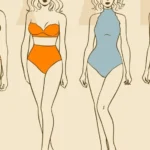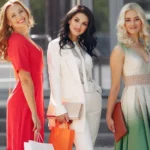The 1970s changed everything about how men dressed. This decade brought us bold patterns, relaxed fits, and a completely new way to think about mens casual outfits.
From bell-bottom jeans to colorful shirts, casual 70s mens fashion created a style revolution that still influences trendy clothes for men today.
Whether you want to recreate authentic looks or add retro touches to modern outfits, understanding this iconic era is essential.
Let’s dive into the world of groovy fashion and discover why these styles remain so influential.
What Made 70s Mens Fashion So Special?
The seventies were a drastic change from the conservative styles of earlier decades. Men finally embraced color, pattern, and personal expression in ways never seen before.
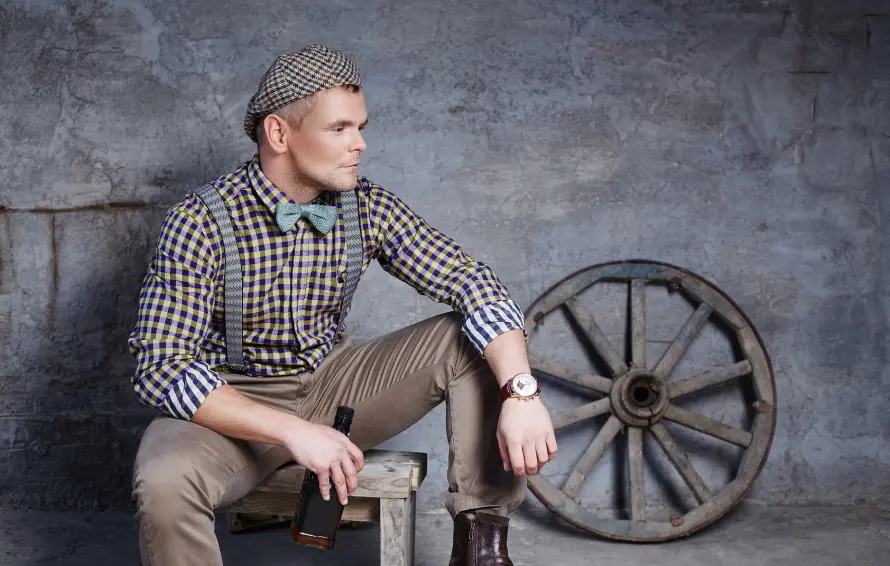
This era brought freedom to mens fashion. Gone were the strict rules of earlier decades. Instead, casual 70s mens fashion encouraged experimentation and individuality.
The decade saw influences from multiple sources. Rock music, disco culture, and social movements all shaped how men chose to dress. This created a unique blend of rebellious and sophisticated styles.
Essential Elements of Casual 70s Mens Fashion
Bold Colors and Patterns
The 70s exploded with color. Earth tones dominated the palette, including:
- Burnt orange
- Mustard yellow
- Avocado green
- Chocolate brown
- Rust red
Patterns played a huge role, too. Paisley prints, geometric designs, and floral motifs appeared on everything from shirts to pants.
These bold choices created mens outfit ideas that were impossible to ignore. Men finally had permission to be visually striking.
Relaxed Silhouettes
Fit changed dramatically in the 70s. Clothing became looser and more comfortable than the fitted styles of the 60s.
Shirts featured wider cuts through the body. Pants sat lower on the hips with relaxed legs. This comfort-first approach influenced casual fashion for decades to come.
The relaxed fit wasn’t just about comfort. It represented a cultural shift toward more laid-back attitudes and lifestyles.
Key Pieces Every 70s-Inspired Wardrobe Needs
Wide-Leg Trousers and Bell-Bottoms
No casual 70s mens fashion look was complete without flared pants. These came in several styles:
Bell-bottoms flared dramatically from the knee down. The bigger the flare, the cooler you looked.
Bootcut jeans offered a more subtle flare. These worked well for everyday wear and paired perfectly with platform shoes.
Wide-leg dress pants brought the flared look to more formal occasions. Made in corduroy or wool, these created sophisticated mens casual outfits.
Patterned Shirts
Shirts in the 70s were anything but boring. Popular styles included:
Paisley button-downs in rich jewel tones. These worked for both casual and dressy occasions.
Geometric print shirts featuring bold, abstract designs. These make perfect statement pieces.
Floral shirts that would have been unthinkable for men in earlier decades. The 70s made flowers masculine and cool.
Denim Everything
Denim exploded in the 70s. Men wore it in ways that seem obvious now but were revolutionary then.
Denim jackets became wardrobe staples. Often worn with matching jeans, this “Canadian tuxedo” look defined casual cool.
Denim shirts worked as versatile layering pieces. They paired well with everything from casual pants to dress trousers.
The key was wearing denim with confidence. The 70s taught men that casual could still be stylish.
The Disco Influence on Mens Fashion
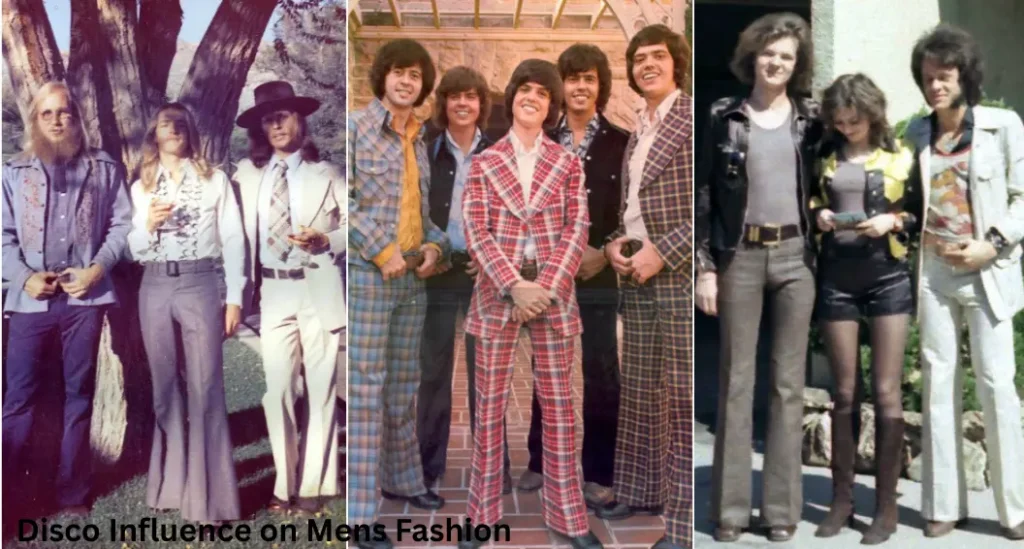
Shine and Glamour
The disco era brought glamour to mens casual outfits. Shiny fabrics like polyester became mainstream choices.
Light in the form of disco balls was reflected by metallic threads in fabrics. This created the signature look of mens disco outfit style.
Satin shirts in jewel tones became weekend wardrobe essentials. These pieces brought luxury to everyday wear.
Form-Fitting Tops
While pants got wider, shirts often got tighter through the disco era. This created the classic 70s silhouette of a fitted top with a flared bottom.
Knit shirts hugged the body in ways that emphasized masculine physiques. This confident display of form was new for mens fashion.
The combination of tight and loose elements created visual interest and showed off both style and physique.
Footwear That Defined the Decade
Platform Shoes
Nothing says 70s like platform shoes. These added height and attitude to any outfit.
Platform boots worked perfectly with bell-bottom jeans. The extra height was a perfect match to the wide leg proportions.
The trend crossed over to more formal events with the platform dress shoes. Even business wear got the ’70s treatment.
Earth-Toned Leather
Shoe colors reflected the decade’s earth-tone palette. Rich browns, tans, and burgundies replaced traditional black and brown.
Suede became incredibly popular. Its soft texture matched the decade’s relaxed attitude perfectly.
These earthy tones coordinated effortlessly with the warm color schemes that dominated casual 70s mens fashion.
Accessories That Completed the Look
Wide Belts
Belts got bigger in the 70s. Broad leather belts with big buckles were among the must-haves.
Tooled leather belts added Western influences to everyday outfits. What, surprisingly, went very well with urban types was this cowboy touch.
Chain belts brought a touch of rebellion to more conservative looks. These accessories showed personal edge and attitude.
Jewelry for Men
The 70s made men wear jewelry in an unprecedented manner. Gold chains became acceptable everyday accessories.
Medallions and pendants hung from longer chains. These pieces reflected personal interests or spiritual beliefs.
Rings beyond wedding bands became common. Men embraced decorative jewelry as part of their personal style expression.
How 70s Fashion Influences Modern Mens Style
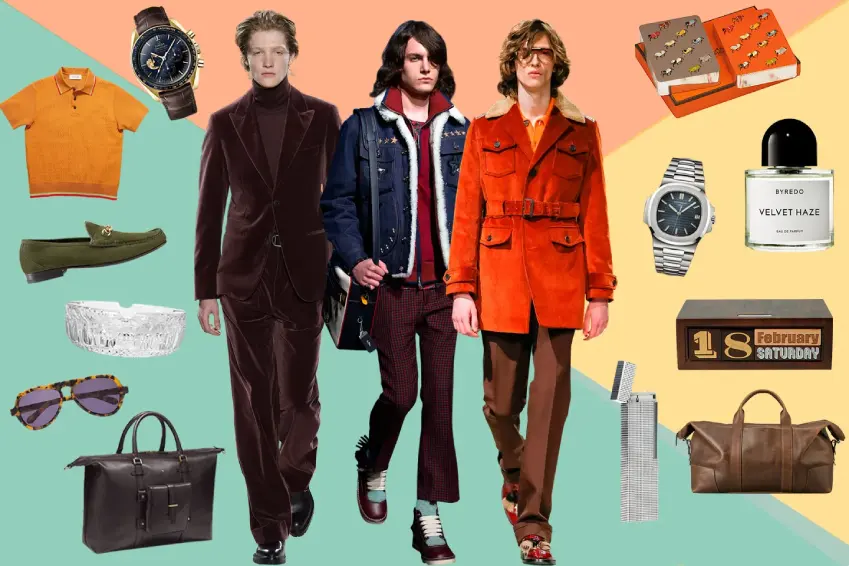
Contemporary Casual Wear
Today’s trendy clothes for men still show 70s influence. Wide-leg pants have returned to mainstream fashion.
Modern designers regularly reference 70s silhouettes and patterns. The audacity with which the decade had undertaken the use of color, print is still invigorating.
Contemporary mens casual outfits often blend 70s elements with current trends. This creates fresh takes on classic looks.
International Style Connections
The 70s influence extends globally. European men’s casual fashion often incorporates retro elements from this era.
Even Japanese casual fashion shows 70s touches in its relaxed fits and earth-tone palettes.
This international appeal proves the lasting power of 70s mens fashion innovation.
Building Your 70s-Inspired Modern Wardrobe
Start with Key Pieces
Begin with a few essential items rather than completely overhauling your wardrobe.
A pair of great wide-leg jeans is the starting point. Dark washes are versatile and on-trend.
Add a patterned shirt in earth tones. Paisley or geometric prints work well for contemporary wear.
Mix Vintage with Modern
The most appropriate strategy is to mix original 70s items with current ones. This creates unique mens outfit ideas that feel fresh.
Vintage band t-shirts paired with modern jeans capture the 70s spirit without looking like a costume.
Contemporary shoes with retro-inspired clothing keep looks grounded in the present while honoring the past.
Choose Quality Over Quantity
Focus on well-made pieces that will last. The 70s emphasized craftsmanship and durability in clothing.
Meaning that natural fibers like cotton, wool, and linen get the aging well that synthetics do not.
Investing in quality pieces ensures your 70s-inspired wardrobe will look authentic and feel comfortable.
Seasonal Considerations for 70s Style
Summer Styling
Warm weather called for lighter fabrics and brighter colors in the 70s.
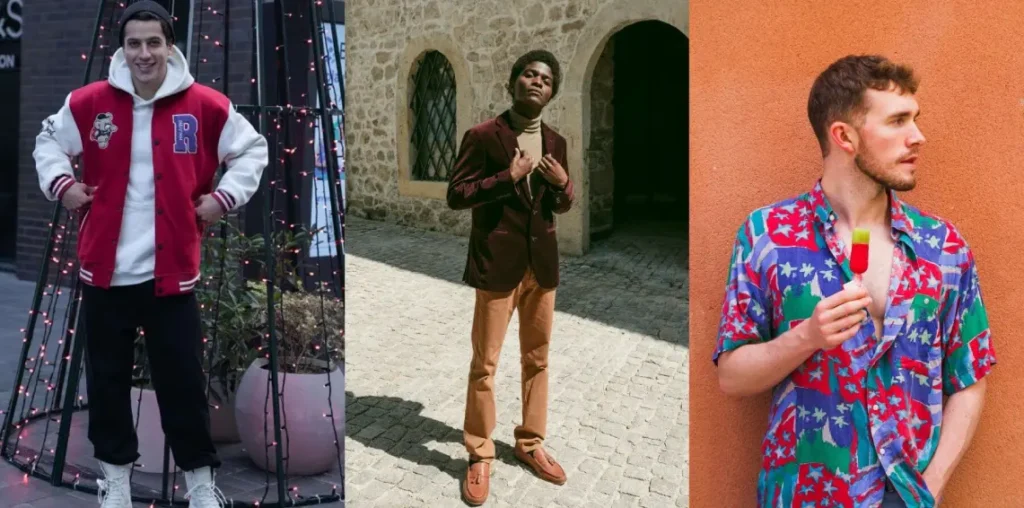
Natural linen shirts were ideal to wear when it was casual and summer. These breathable fabrics kept men comfortable in the heat.
Shorter shorts became acceptable for the first time. The 70s normalized showing more legs in casual settings.
Winter Warmth
Cold weather brought out rich textures and deeper colors.
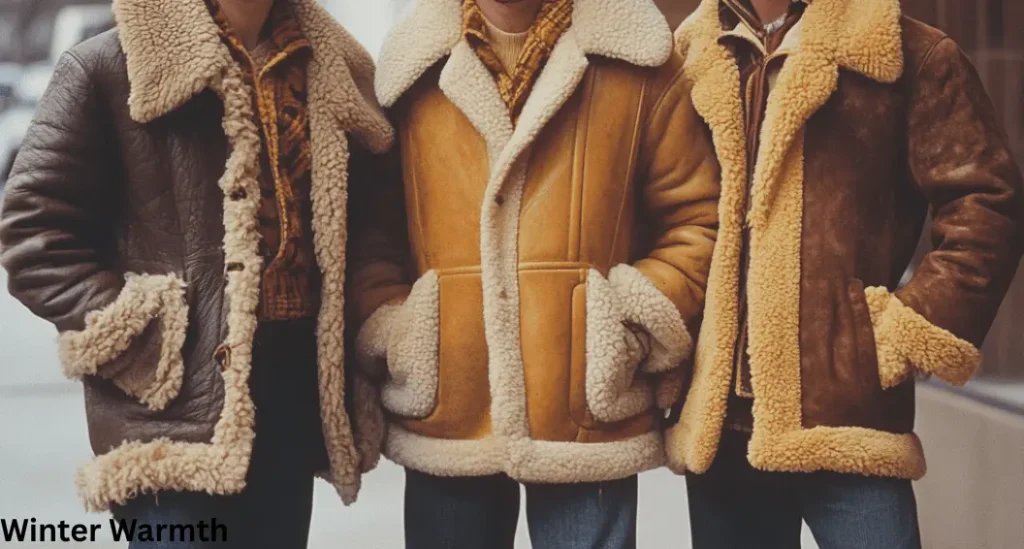
Corduroy pants in chocolate brown or forest green provided warmth and style. These combed fabrics were used to bring life to the winter clothes
Turtleneck sweaters became masculine staples. Previously considered feminine, the 70s made these pieces acceptable for all men.
Common Mistakes to Avoid
Over-Accessorizing
While the 70s embraced bold choices, successful looks maintained some restraint.
Choose one statement piece per outfit rather than combining multiple bold elements.
Let your main piece shine by keeping other elements more subdued.
Wrong Proportions
The 70s silhouette worked because of careful proportion balance.
If you are opting for wide-leg pants, then strictly go for a more fitted top. This maintains the classic 70s shape.
Avoid pairing loose tops with loose bottoms. This creates shapeless looks that miss the point of 70s style.
The Cultural Impact of 70s Mens Fashion
Breaking Gender Norms
The decade challenged traditional ideas about masculine dress.
Colors previously considered feminine became acceptable for men. This opened up entirely new style possibilities.
Male interest in appearance and fashion became the defaulted status as they wore fitted clothes and used fancy accessories.
Expressing Individuality
For the first time, men’s fashion encouraged personal expression over conformity.
Different subcultures developed distinct style approaches. Both rock, as well as disco, and casual rounded it off and were genuine options.
This diversity in mens casual outfits created space for individual creativity and personal taste.
Modern Shopping for 70s Style
Vintage vs. Reproduction
Vintage products, which are authentic and original, provide original materials and construction of the period.
Reproduction items provide 70s looks in modern fits and fabrics. These often work better for contemporary lifestyles.
Mixing both approaches creates the most versatile and wearable 70s-inspired wardrobe.
Where to Find Authentic Pieces
Lots of real 70s treasures can also be found at thrift shops for very affordable prices.
Vintage clothing shops specialize in authenticated pieces from specific eras.
Online marketplaces offer vast selections but require careful attention to sizing and condition.
Caring for 70s-Style Clothing
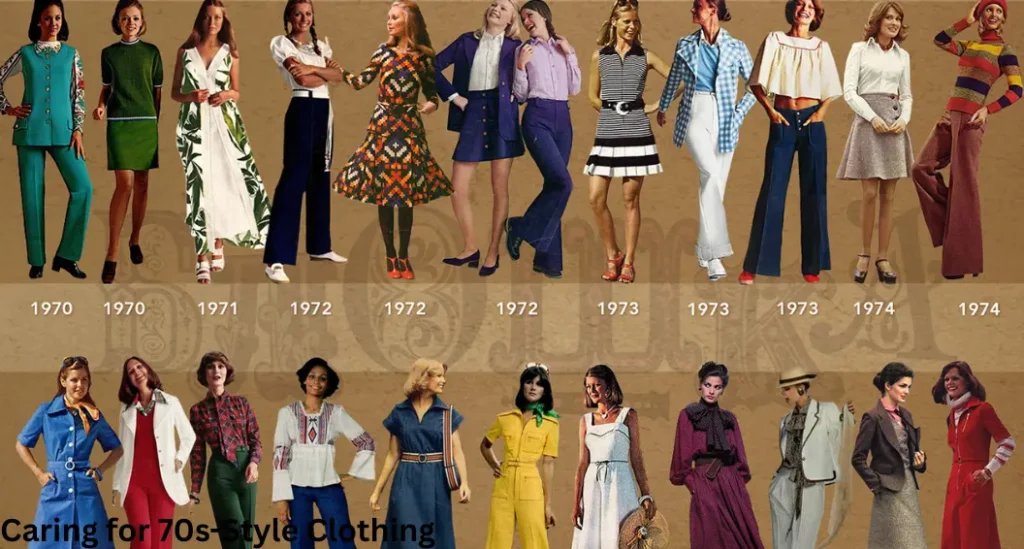
Fabric Considerations
Many of the fabrics of the 70s need special treatment in order to keep their look.
Polyester blends should be washed in cool water to prevent shrinking and fading.
Natural fibers like cotton and linen may need professional pressing to maintain their crisp appearance.
Storage Tips
Proper storage extends the life of vintage and vintage-inspired pieces.
Hanging shirts and jackets will help them maintain their shape and keep wrinkles away.
Before putting things away, fold pants along creases.
Conclusion
Casual 70s mens fashion represents one of the most influential periods in menswear history. This decade broke down barriers, introduced bold new elements, and permitted men to express themselves through clothing.
The key principles of 70s style remain relevant today. Comfort, color, pattern, and individual expression continue to shape modern mens casual outfits.
Whether you’re drawn to the full retro experience or just want to add some 70s flair to contemporary looks, these timeless principles will serve you well. The groovy spirit of the 70s reminds us that fashion should be fun, expressive, and authentically you.
Remember, the best casual 70s mens fashion isn’t about perfect historical accuracy. It’s about capturing the decade’s spirit of confidence, creativity, and self-expression in ways that work for your modern lifestyle.
Frequently Asked Questions
Q: What are the most important pieces for a 70s-inspired mens wardrobe?
A: Start with wide-leg jeans, a patterned shirt in earth tones, and a good denim jacket. These three pieces form the foundation of authentic casual 70s mens fashion and can be mixed with modern items easily.
Q: Can I wear 70s fashion to work?
A: Yes, but choose subtle elements. Try wide-leg trousers in neutral colors or incorporate earth-tone shirts into your professional wardrobe. The key is adapting 70s principles to your workplace dress code.
Q: How do I avoid looking like I’m wearing a costume?
A: Mix vintage-inspired pieces with modern items rather than wearing head-to-toe 70s looks. Choose one or two key ’70s elements per outfit and keep the rest contemporary.
Q: What’s the difference between 70s fashion and other vintage decades?
A: The 70s emphasized relaxed fits, earth tones, and bold patterns more than other eras. Unlike the structured looks of the 1920s men’s fashion or the minimalism that followed, 70s style celebrated comfort and individual expression.
Q: Do we need platform shoes in order to look 70s?
A: While platforms were popular, they’re not essential. Modern boots or sneakers can work well with 70s-inspired outfits. Focus on the overall silhouette and color palette rather than exact historical accuracy.
Q: How do I choose the right fit for wide-leg pants?
A: Your waist should be at your natural waist, not your hips. The legs should be wide but not overwhelming your frame. Start with a moderate flare and work up to wider styles as you get comfortable with the look.



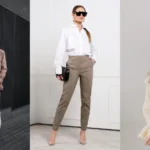

 Explore stunning outfit ideas, the latest fashion trends, and effortless styling tips at What to Wears.
Explore stunning outfit ideas, the latest fashion trends, and effortless styling tips at What to Wears.
